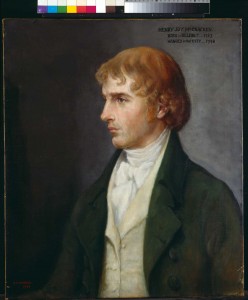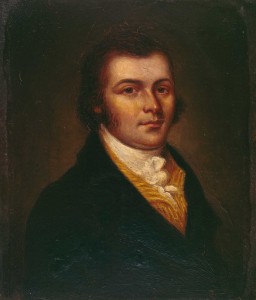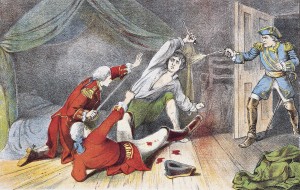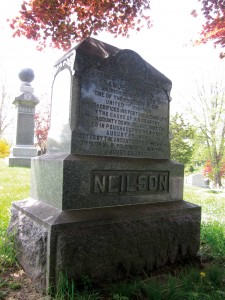‘A planet of light and heat’: Samuel Neilson and the Northern Star
Published in 18th–19th - Century History, Features, Issue 6 (November/December 2015), Volume 23ON THE HILL OF TARA, CO. MEATH, NEXT TO THE LIA FÁIL, IS A MONUMENT COMMEMORATING THE REBELLION OF 1798. SOME 3,000 MILES AWAY, IN A CEMETERY IN POUGHKEEPSIE, NEW YORK, IS ANOTHER MONUMENT, MARKING THE GRAVE OF A MAN WHO DEVOTED HIS LIFE TO THE VISION OF A FREE AND UNIFIED IRELAND.
By Joshua J. Mark

Henry Joy McCracken—in 1791 Neilson suggested to his friend the idea of forming a society based on Wolfe Tone’s Argument on behalf of the Catholics of Ireland, which championed equal rights and treatment before the law for everyone. (Ulster Museum)
Samuel Neilson (1761–1803), while not as widely recognised as others who participated in the 1798 rebellion, such as Wolfe Tone, Lord Edward Fitzgerald or William Orr, played an integral role in the revolutionary politics of the 1790s, primarily as editor of the Northern Star newspaper, described by Walter Cox in 1811 as:
‘… a planet of light and heat; its influences were commensurate with its circulation and its circulation was only restricted by the ocean. It warmed the cold; it animated the feeble; it cheered the afflicted; it stimulated the intrepid and instructed all. Pernicious dogmas, false reasonings, slavish superstitions and gothic prejudices, which broke the people into different sects and marshalled them against each other, disappeared before it.’
Independent source of news
The Northern Star was an independent source of news in Ireland at a time when the Castle-controlled press was the only outlet for information. It is not surprising to read Cox’s description of it as a force that broke down barriers and prejudices among the people, because the publication was born out of the vision of the Society of United Irishmen to unite ‘Catholic, Protestant and Dissenter’ under the common name of Irishmen. That vision was articulated by Wolfe Tone but it was Neilson who shared it with every person in Ireland who read the Northern Star or who heard it read aloud. Gillian O’Brien writes how, ‘in late eighteenth-century Ireland, the purchase of the Northern Star was as potent a symbol of freethinking, independent citizenship as bearing arms’. The paper was the mouthpiece of the United Irishmen, and Samuel Neilson was the man who devoted himself to ensuring that it reached as many people as possible.

Samuel Neilson (1761–1803) played an integral role in the revolutionary politics of the 1790s, primarily as editor of the Northern Star newspaper. (Ulster Museum)
The spirit of revolution was in the air throughout the latter part of the eighteenth century. The British colonies in North America had successfully gained their independence. In 1789 the French had thrown off their monarchy in their own revolution and dedicated themselves to the principles of liberty, equality and fraternity. The example of oppressed people breaking free of tyrannical rule was carefully noted by the politically minded in Ireland. While these revolutions were going on, the Catholic majority population in Ireland had almost no rights at all. The wealthy landowners and aristocrats were Anglicans of the Church of Ireland, aligned with English rule, and used their political power to enact the penal laws to deprive Irish Catholics of their lands and fortunes. In 1641 Catholics held 59% of the land; by 1703 they held only 14%. No Catholic could serve in the armed forces or possess arms; they could not ride a horse worth more than five pounds, could not vote or attend school or serve in government, and were forced to pay a tithe to the Anglican Church.
Irish Presbyterians and Dissenters suffered similar injustices and persecutions (although less harsh), a fact of which Neilson was keenly aware. In 1791 he became involved in the Volunteer movement, a militia organised during the American Revolution, when British troops stationed in Ireland were deployed to North America. The military authority of these militias emboldened some to exercise what political power they could to effect change in Ireland. A life-long Presbyterian, Neilson nevertheless saw no significant distinction between Catholics and those of his own church and suggested to his friend, the political activist Henry Joy McCracken, the idea of forming a society based on Wolfe Tone’s Argument on behalf of the Catholics of Ireland, which championed equal rights and treatment before the law for everyone.
Neilson believed that a united society was the imperative first step in galvanising the people into action and, following the examples of the North American colonies and France, freeing Ireland from tyranny. Wolfe Tone and Thomas Russell (both Anglicans) joined with Neilson and McCracken and other like-minded Irish intellectuals in establishing the Society of United Irishmen in October 1791 in Belfast. The Northern Star was conceived as a voice of dissent, a necessary alternative to the Castle-controlled press in Ireland, and was launched in January 1792 with Neilson as editor.
The Northern Star broadcast the central principles of the United Irishmen:
‘1. That the weight of English influence in the government of this country is so great as to require a cordial union among all the people of Ireland, to maintain that balance which is essential to the preservation of our liberties and the extension of our commerce.
2. That the sole constitutional mode by which this influence can be opposed is by a complete and radical reform of the people in Parliament.
3. That no reform is just which does not include Irishmen of every religious persuasion.’
Neilson, his staff and supporters repeatedly weathered the legal storms for libel brought against him and his paper by the authorities from 1792 to 1795. When the pressure from the Castle became too great, many of those originally associated with the paper distanced themselves. Neilson then took all of the risks on his own, maintaining the press until his arrest for sedition in 1796. He and Russell and any others found on site were taken to Newgate prison in Dublin and then on to Kilmainham jail, while the paper’s offices were ransacked by the militiamen who had arrested them.
Circulation
During its run, the Northern Star was distributed throughout Ireland, achieving a circulation of almost 5,000 subscribers, not counting those who read the paper in pubs or heard it read to them. Jonathan Bardon writes that the Northern Star, with Samuel Neilson as editor, ‘became the most widely read newspaper in Ireland’, and, displaying his keen business acumen, Neilson even made the publication profitable. In May 1797 the Monaghan militia wanted to place a declaration of loyalty in the Northern Star. The staff refused unless an offending sentence, referring to Belfast as a town notorious for seditious practices, was removed from the piece. In response, the militia destroyed the printing presses of the Northern Star, ending the paper’s run.

Following the arrest of Lord Edward Fitzgerald on 18 May 1798, Neilson was the only national United Irish leader still at large. He suffered the same fate on the night of the outbreak of the insurrection, 23 May. (NLI)
When Neilson was released in February 1798 (owing to failing health from his time in Kilmainham jail) it was on condition that he not associate with any treasonable persons or engage in any seditious activities. Neilson, however, ignored these restrictions and returned to his former cause, even though he now had no means of printing or distributing the Northern Star. Neilson felt, more than he had before, that the time for the rebellion was at hand and it was he who came up with the plan to signal the start of the rebellion: to stop the mail coaches. The failure of the coaches to appear at the usual time would be the signal to rise. The rebellion’s date had not yet been decided when, on 12 March 1798, almost the entire United Irish Leinster leadership, including Oliver Bond, were arrested at Bond’s house in Dublin following a tip-off to the authorities by the traitor Thomas Reynolds. The arrest of Bond and the others momentarily stalled plans for the uprising.
Preparations for rebellion
Neilson and rebel leader Lord Edward Fitzgerald were still at large, however, with Fitzgerald hiding in a house in Thomas Street in Dublin and Neilson bringing him whatever intelligence could be gathered. It has been claimed by some historians (Bardon among them) that the authorities were watching Neilson and followed him to Fitzgerald, but more recent scholarship makes clear that Fitzgerald was betrayed by a fellow member of the United Irishmen, a man at whose house he had dined and whom he trusted, one Francis Magan, who reported Fitzgerald’s whereabouts to the authorities in May. The date of the rebellion was set for 23 May and Fitzgerald was the man to lead it, with Neilson’s strategy in place for Dublin to rise as the flashpoint and surrounding counties to then follow suit. On 18 May, however, the authorities raided the house in Thomas Street, following Magan’s tip; Fitzgerald was critically wounded and taken to Newgate prison.
On the night of 23 May, Neilson was reconnoitring Newgate for a surprise attack to free Fitzgerald when he was recognised by one of his former jailers; though he tried to escape, he was overpowered, beaten and arrested. The rising began the next morning just before dawn, but again, because of treachery, the authorities were aware of the threat and had mobilised the Yeomanry in Dublin to police the streets so rigidly that the rebels had no chance to enact their plan. Neilson’s strategy of stopping the government coaches failed owing to a lack of leadership and organisation. Rebel forces outside Dublin did rise but in an uncoordinated fashion, and by September the rebellion had been crushed. As the authorities executed and massacred insurgents, Neilson remained in prison with the others taken when the rebellion began.

‘SACRED TO THE MEMORY OF SAMUEL NEILSON AN IRISH PATRIOT OF 1798 ONE OF THE FOUNDERS OF THE UNITED IRISHMEN WHO SACRIFICED HIS FORTUNE AND HIS LIFE IN THE CAUSE OF HIS COUNTRY. BORN IN COUNTY DOWN, IRELAND, Sept 1761. DIED AUGUST 29, 1803. ERECTED BY THE ANCIENT ORDER OF HIBERNIANS DIVISION No. 2, POUGHKEEPSIE, NEW YORK, AUGUST 29, 1905.’
Exile and death
Neilson and the other rebels had been moved from Newgate to Kilmainham jail, except for Fitzgerald, who died of the wounds he received at his arrest. From Kilmainham, Neilson was exiled to Fort George in Scotland and remained a prisoner there until 30 June 1802, when he was deported with the others to the Netherlands. The English insisted that none of these men ever return to Ireland. Neilson defied English law by visiting his wife and children after his release and then left for the United States from Dublin. He arrived in December 1802, most probably at the docks of South Street in Manhattan, New York. His plan was to start up another Northern Star in America and continue the fight for Irish independence by organising another Society of United Irishmen. He was preparing to publish his paper and bring his wife and family over from Ireland when a yellow fever epidemic struck New York in August 1803.
Neilson took passage on a boat that was heading north to Poughkeepsie on 28 August but it was too late; he was already infected with the fever and died the next day, 29 August 1803, at the age of 43. The weekly Political Barometer of 6 September reported:
‘Some few weeks since, Mr Neilson issued proposals for publishing an evening paper in New York; driven from thence by the calamitous disease which now prevails in the city, he was taken sick on his passage up the river, landed here on Sunday, and died Monday morning; his remains were decently interred in the Dutch Presbyterian burying ground in this village.’
When that cemetery was sold for redevelopment and the graves moved, Neilson’s body was interred in the new Episcopal cemetery on Montgomery Street in 1830; when that in turn closed, his remains were relocated to plot 94A of the Poughkeepsie Rural Cemetery in 1880. The grave remained unmarked, however, until identified by the writer Thomas Addis Emmet. On 29 August 1905 the present stone was unveiled with great ceremony, an event attended by a large crowd of admirers, and, in the words of one journalist, ‘the gallant Irishman got his just reward’.
Samuel Neilson could have lived a comfortable life with his wife and family. He clearly had an acute business sense and a talent for the written word. He chose instead to devote himself to the good of the people through the publication of the Northern Star. Unlike Wolfe Tone or Lord Edward Fitzgerald, Neilson had no dramatic or heroic exit from life, but, just like them, he gave his life and sacrificed his family for the cause of Irish freedom from English oppression. His grave rests many miles from the land he sought to free, but for those who respect his sacrifice it serves as a reminder of what could have been had the rebellion of 1798 succeeded, and of the values of liberty and equality for which so many would rather die than live without.
Joshua J. Mark is an editor and writer for Ancient History Encyclopedia and a part-time professor at Marist College, Poughkeepsie, New York.
Further reading
J. Bardon, A history of Ireland in 250 episodes (Dublin, 2008).
G. O’Brien, ‘Spirit, impartiality and independence: the Northern Star, 1792–1797’, Eighteenth-Century Ireland/Iris as Dá Chultúr 13 (1988).
Read More: Background
















